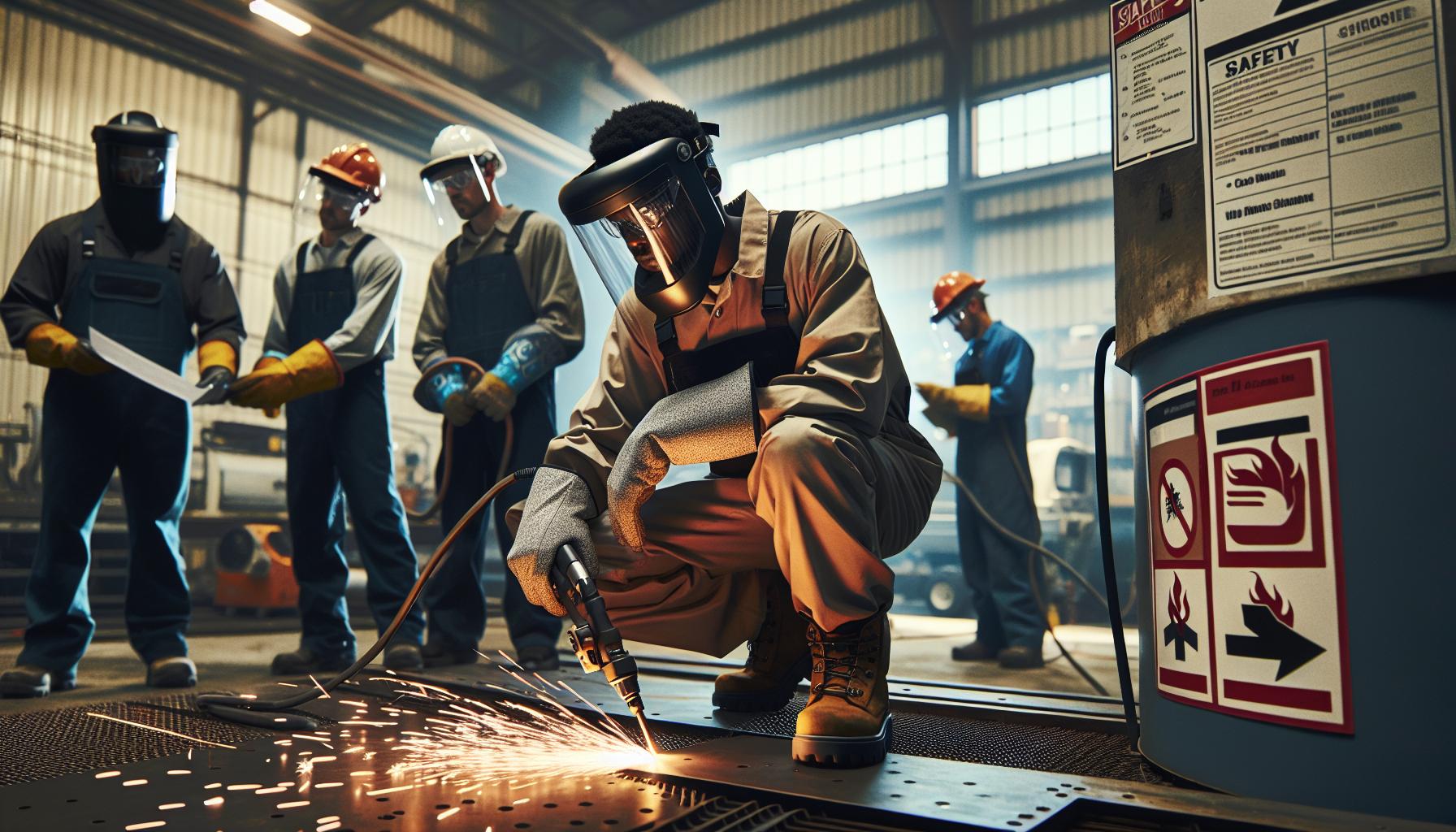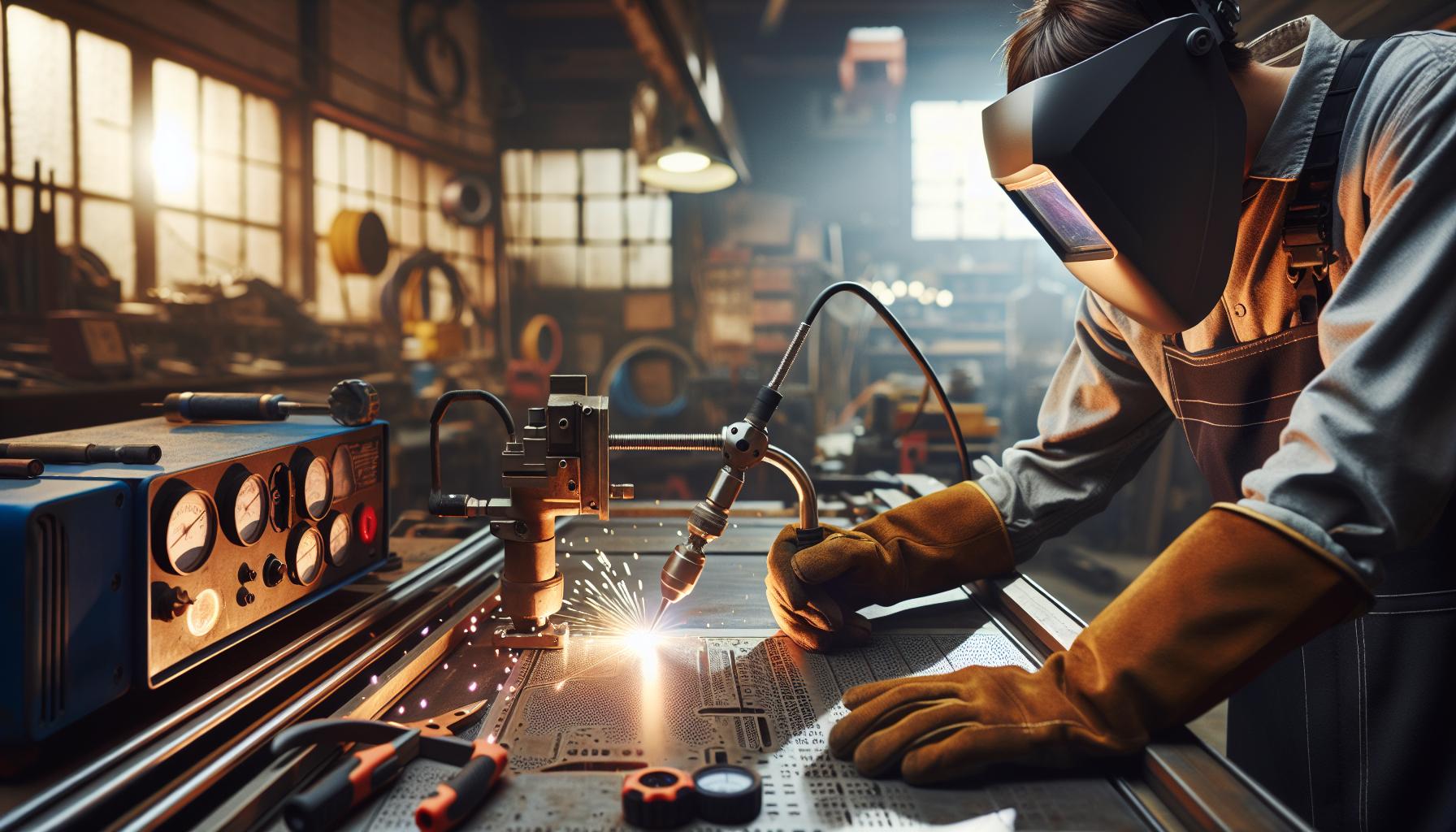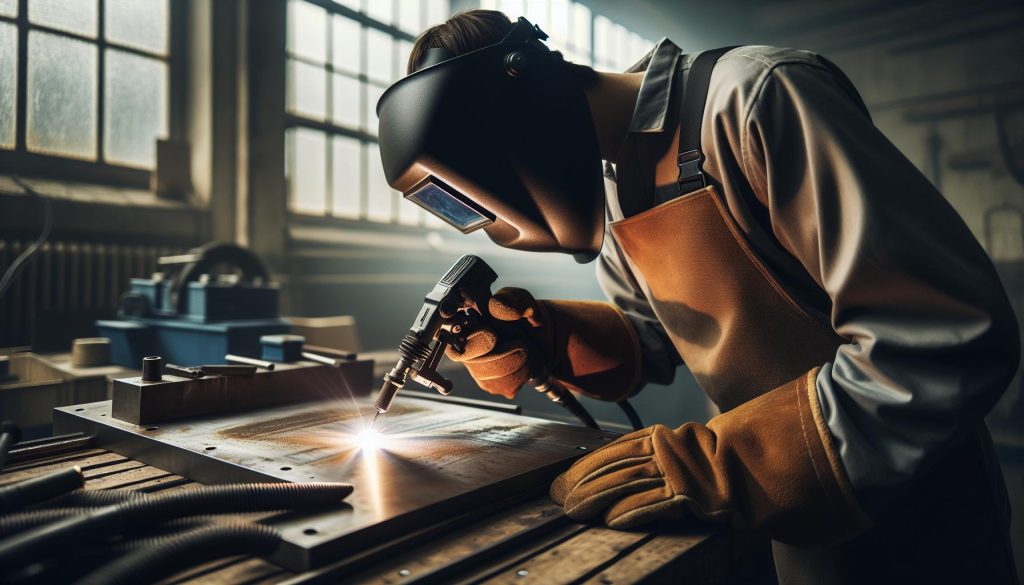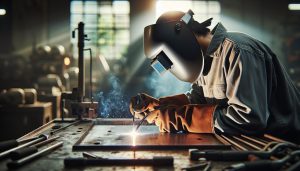Did you know that mastering plasma cutting can elevate your metalworking skills significantly? Plasma cutting not only allows for precision in cutting thick materials like steel but also enables intricate designs, making it an invaluable technique for welders and fabricators alike. This comprehensive guide, “How to Gouge With a Plasma Cutter: Advanced Techniques Revealed,” will help you understand the intricacies of gouging – a technique essential for removing welds, repairing surfaces, or creating artistic designs. Whether you’re a seasoned professional or just starting your welding journey, this article will provide you with advanced insights and practical tips to enhance your plasma cutting prowess. Get ready to explore safety protocols, essential equipment, and innovative methods that will ensure you achieve clean, effective results. Dive in and discover how to harness the full potential of your plasma cutter, transforming your welding projects with precision and creativity.
Understanding Plasma Cutters: The Basics You Need to Know
Understanding plasma cutters opens the door to a world of precision and versatility in metalworking, a valuable asset for both hobbyists and professionals. At their core, plasma cutters utilize an electrical arc to ionize gas-typically air-creating a high-temperature plasma that can cut through conductive materials such as steel, aluminum, and brass with exceptional speed and accuracy. This process is not only efficient but allows for intricate designs, making plasma cutting a favored choice in fabrication tasks from automotive repair to artistic metalwork.
The components of a plasma cutter are designed to work seamlessly together to produce optimal cutting results. The machine consists of a power supply, a torch, and a nozzle. The power supply generates a high-voltage electric arc, while the torch allows the operator to control the direction and intensity of the plasma flow. Understanding how to adjust the settings on your plasma cutter can significantly affect the quality and speed of your cuts. Operators should consider variables such as air pressure, amperage, and cutting speed-each influencing the cut quality, kerf width, and overall finish of the material.
For those new to plasma cutting, familiarizing yourself with the specific types of plasma cutters available on the market is an important step. There are air plasma cutters, which are suitable for general cutting tasks, and more advanced systems, like water plasma cutters that minimize distortion and heat-affected zones in sensitive materials. Beginners should start with a basic model to grasp the fundamentals, while experienced welders might explore dual-function machines that combine plasma cutting with other welding techniques for greater versatility.
It’s also vital to consider safety when operating plasma cutters. The intense heat and bright arc produced during the cutting process can be hazardous. Ensuring proper protective gear, including gloves, goggles, and flame-resistant clothing, is crucial. Familiarity with the machine’s settings and capabilities can prevent accidents and ensure high-quality results. As you explore the world of plasma cutting, a solid understanding of the basics provides a strong foundation for mastering more advanced techniques and achieving precision in your projects.
Essential Safety Protocols for Plasma Cutting

Operating a plasma cutter demands rigorous adherence to safety protocols to prevent accidents and ensure a safe working environment. Given the extreme heat and light generated during the cutting process, the potential hazards are significant. Not only can the bright arc blind an operator, but the high temperatures can also ignite flammable materials nearby. Therefore, it is crucial to implement comprehensive safety measures.
First, equipping oneself with appropriate personal protective equipment (PPE) is non-negotiable. Always wear welding helmets with appropriate lenses to prevent eye damage from the bright arc. In addition, flame-resistant clothing, gloves, and steel-toed boots should be standard attire to protect against sparks and molten metal. It’s advisable to ensure that your workspace is free from unnecessary clutter and flammable materials. Designate a safe cutting area and keep it clean to avoid accidents.
Important Safety Practices
Implementing routine safety checks is another essential protocol. Before operating the equipment, inspect the plasma cutter for any signs of wear or malfunction. This includes checking the power supply, connections, and the condition of the torch and consumables. Confirm that all safety features are functioning properly to prevent hazardous situations during operation.
In addition to equipment checks, ensure proper ventilation in the workspace. Fumes generated during plasma cutting can be harmful if inhaled. Using fume extraction systems can significantly reduce the risk of respiratory issues. Furthermore, having fire extinguishing equipment readily available in the event of an unexpected fire is paramount.
Finally, maintaining communication with others in the workspace can enhance safety. Using hand signals or visual cues can help convey important information when loud machinery drowns out verbal communication, ensuring that everyone’s aware of the operation being conducted.
By adhering to these essential safety protocols, operators can significantly reduce the risks associated with plasma cutting, creating a safer and more efficient working environment.
Materials Suited for Gouging: Choosing the Right Options

Selecting the appropriate materials for gouging with a plasma cutter is essential for achieving optimal results and ensuring safety during operations. Plasma gouging is versatile and can be applied to a variety of metals, each with its own set of characteristics. Steel, stainless steel, aluminum, and other alloys present unique challenges and advantages that every welder should understand.
When dealing with mild steel, for instance, its popularity stems from its favorable price and ease of use. Plasma cutting can penetrate this material quickly, making it ideal for both thin and thick sections. Adjusting the plasma cutter settings for gas flow rate and amperage is crucial-higher settings are recommended for thicker materials to ensure efficient cutting and better control of the gouging process.
Stainless steel is another common choice, particularly in industries requiring corrosion resistance. It operates effectively under plasma cutting, but it demands careful attention to parameters such as speed and torch angle to prevent burn-through. Following best practices, like starting with a lower amperage and increasing it as necessary, will aid in providing clean and precise gouges.
Aluminum, while lighter and more malleable, presents its own challenges due to its thermal conductivity. Plasma cutting aluminum often requires different consumables and settings to manage the heat effectively and avoid warping. It’s advisable to set your machine to a higher travel speed and to maintain a steady hand, ensuring uniform gouging without melting through the base metal.
Lastly, cast iron and other alloys can generally be gouged but may require specialized techniques. The varying compositions affect how the plasma interacts with the material, making it essential to test parameters on scrap pieces first.
In summary, understanding the characteristics of the materials you are gouging is pivotal for success. Here’s a quick reference guide for selecting materials:
| Material | Characteristics | Recommended Settings |
|---|---|---|
| Mild Steel | Cost-effective, easy to cut | Higher amperage for thick sections |
| Stainless Steel | Corrosion-resistant, sensitive to heat | Lower amperage, carefully control speed |
| Aluminum | High thermal conductivity, lightweight | Higher travel speed, steady hand |
| Cast Iron | Hard and brittle, requires testing | Start with lower settings; adjust as needed |
By carefully selecting materials and their corresponding settings, you can enhance the performance of your plasma cutter, yielding cleaner cuts and safer operations. Emphasizing preparation, testing, and adaptability will ensure that your gouging tasks go smoothly and efficiently.
Mastering the Plasma Cutter Settings for Optimal Performance

To achieve precision and effectiveness with a plasma cutter, understanding and mastering the settings is crucial. The correct configuration can significantly impact the quality of gouging, influencing factors such as cut speed, edge quality, and overall efficiency. For example, adjusting the amperage based on material thickness is a fundamental practice. Higher amperage settings are typically recommended for thicker materials to provide sufficient energy for penetration, while thinner materials require lower settings to prevent unwanted burn-through.
Key Settings to Manage
A few essential parameters to focus on include:
- Amperage: This setting determines the output current and directly affects the intensity of the cut. For instance, when gouging mild steel, use higher amperage for thicker sections to increase the speed and depth of the cut.
- Gas Flow Rate: The right gas flow ensures that the plasma is stable and protects the torch and material. A higher flow rate helps keep the arc concentrated but too much can lead to wasted gas and irregular cuts.
- Cut Speed: This is how quickly the torch is moved across the material. Faster speeds can reduce heat exposure but may lead to poor cut quality. Adjusting the speed based on the material and thickness is vital.
- Torch Angle: The angle of the torch during gouging can influence the cut profile. A slight angle can help direct the plasma arc and improve gouging efficiency.
Adapting Settings for Different Materials
Each material presents unique challenges that require tailored settings. For instance, gouging stainless steel often necessitates starting with lower amperage and incrementally increasing it to avoid burn-through, while aluminum demands a higher travel speed due to its excellent thermal conductivity. Testing these settings on scrap pieces prior to the actual workpiece can provide insights into how different materials react under various conditions.
A practical approach to mastering plasma cutter settings begins with gaining familiarity with your specific equipment and materials. By understanding how each parameter interacts, skilled welders can manipulate settings to suit their unique needs, resulting in cleaner cuts and enhanced control over the overall gouging process. Achieving proficiency in these adjustments not only improves precision but also boosts confidence in handling various welding tasks effectively.
Advanced Gouging Techniques: Strategies for Precision Work
To achieve optimal results when gouging with a plasma cutter, it’s essential to implement advanced techniques that enhance precision and control. One of the critical strategies is to maintain a steady hand while moving the torch. Variability in movement, even by small margins, can lead to differences in cut quality. A consistent speed helps ensure a uniform cut, which is especially important when gouging more intricate designs or edges. Utilizing guide rails or templates can provide physical assistance in maintaining this consistency, reducing the likelihood of waver during the gouging process.
Another approach to refining your gouging skills involves careful manipulation of the cutting angle. While a standard 90-degree angle is common, experimenting with slight adjustments can yield different gouging profiles. For instance, tilting the torch toward the direction of the cut can help channel the plasma more effectively, potentially enhancing the depth of the gouge while minimizing metal distortion. Maintaining a perpendicular position ensures the arc maintains a steady and concentrated plasma flow, which is crucial for achieving a clean edge.
Incorporating Oscillation Techniques
Many experienced welders leverage oscillation techniques to significantly improve gouging precision. This involves subtly moving the plasma cutter back and forth while advancing along the cut line. Oscillation not only expands the width of the gouge but also aids in cooling the material during cutting, which can mitigate warping or other heat-related issues. An ideal oscillation pattern typically involves a gentle rhythm that matches the forward speed of the cut, allowing for fluid motion without compromising control.
Moreover, understanding the interplay between amperage settings and gouging speed is vital for advanced applications. For thicker materials, gradually increasing the amperage while controlling the speed allows for deeper penetration without burning through the material. Utilizing scrap pieces for practice with different settings can provide valuable insights into this relationship, enabling welders to fine-tune their techniques specific to the materials used.
Ultimately, combining these advanced strategies ensures higher precision in plasma gouging, setting the stage for creating complex designs and robust edges. By continually practicing these techniques and adapting settings based on individual experiences with different materials, welders can build confidence and proficiency, significantly elevating their craft.
Creating Unique Designs with Plasma Cutting
The versatility of plasma cutting technology opens up a world of creative possibilities, enabling artisans and fabricators alike to produce intricate designs with precision and flair. At the core of this process lies a profound understanding of the plasma cutter’s capabilities, which allow operators to manipulate the arc and adjust settings to achieve unique artistic expressions across various materials. Whether crafting ornamental pieces, custom signage, or automotive parts, mastering the art of design through plasma cutting can set your work apart in the industry.
One effective strategy for creating unique designs involves harnessing the power of templates and stencils. By cutting out shapes from materials like cardboard or plastic, you can easily transfer complex designs onto the workpiece, maintaining consistency and accuracy during the cutting process. Additionally, utilizing advanced software to create digital designs that can be translated into cutting paths enhances creativity significantly. Many plasma cutters are compatible with computer-aided design (CAD) programs, allowing for detailed graphics that can be reproduced with high precision in metal, resulting in professional-quality pieces.
Experimenting with Cutting Parameters
Another aspect that influences the uniqueness of your plasma-cut designs is the experimentation with cutting parameters. By varying the speed, amperage, and cutting angles, you can create different effects and textures within your cuts. For instance, a slower cutting speed may yield a smoother edge, while a faster speed can create a more ragged finish that may complement the overall aesthetic of certain designs. Moreover, adjusting the angle of the torch during the cut can produce varied depths and widths, further enhancing the dimensionality of your artwork.
Incorporating mixed media can also elevate your audience’s experience. Consider combining plasma-cut metal components with materials such as wood or glass to develop multidimensional installations or functional art pieces. This not only widens your creative palette but also offers unique challenges that can enhance your skills in manipulating various materials. Always remember to maintain safety protocols when experimenting with new techniques to ensure a smooth and secure working environment.
By embracing the creative potential of plasma cutting technology, operators can craft unique designs that not only showcase technical skills but also reflect individual artistic visions. Whether leveraging templates, experimenting with parameters, or integrating mixed media, the possibilities are limited only by your imagination.
Troubleshooting Common Plasma Cutting Issues
Plasma cutting is an incredibly efficient and versatile technique, but even seasoned operators can encounter common issues that disrupt the gouging process. Understanding these potential problems and their solutions is crucial for maintaining a smooth operation. A frequent issue that arises is poor cut quality, often manifested as excessive dross or jagged edges. This can usually be traced back to incorrect settings, such as the travel speed being too slow or the amperage being too low for the material thickness being cut. Adjusting these parameters can vastly improve the outcome; experiment with increasing the speed or amperage, or using a higher-quality plasma torch consumable to create cleaner cuts.
Another common challenge is an unsteady or erratic arc, which can lead to inconsistent gouging results. This may be caused by a variety of factors including a dirty workpiece, faulty ground connections, or worn-out torch components. Ensuring the surface is clean, adequately grounding your work, and regularly maintaining your torch by replacing worn nozzles and electrodes can significantly enhance arc stability. If your plasma cutter is showing signs of fluctuation, inspect the consumables and consider conducting a test cut with a different material to rule out equipment malfunction or compatibility issues.
Occasionally, operators may find that their plasma cutter is not cutting through the material effectively. This could be attributed to several factors: choosing the wrong nozzle size, using insufficient compressed air, or operating at an unsuitable distance from the workpiece. For optimal performance, it’s essential to match your nozzle to the material thickness and maintain a consistent cutting distance, ideally around 1/16 to 1/8 inch above the surface. Additionally, ensure that the air pressure is within the recommended range for your specific cutter model, as proper air flow is vital for maintaining the quality of the plasma arc.
Lastly, operator fatigue and lack of concentration can inadvertently affect the quality of gouging work. This is particularly critical during intricate designs or lengthy cutting sessions. To mitigate this, take regular breaks and implement ergonomic practices to reduce strain, allowing for greater focus and precision during work. By staying vigilant to these common troubleshooting scenarios, operators can enhance their gouging proficiency and ensure a high standard of work, maximizing the full potential of their plasma cutting capabilities.
Maximizing Efficiency: Tips for Faster Gouging
Achieving faster gouging with a plasma cutter requires a combination of proper technique, equipment settings, and strategic planning. One of the most effective ways to maximize efficiency is to ensure that your plasma cutter is properly configured for the specific material and thickness being worked on. This involves selecting the right amperage and travel speed. Higher amperage allows for a more robust arc, which can cut through thicker materials more rapidly. However, balancing the travel speed is crucial; too fast can lead to poor cut quality, while too slow can waste time and increase dross formation.
Another essential factor to consider is the quality of your consumables. Worn-out nozzles and electrodes can significantly impact the efficacy of your cuts and lead to increased downtime during maintenance or replacements. Investing in high-quality consumables not only enhances cut quality but also reduces the frequency of changes, allowing you to maintain a continuous workflow. Regularly inspecting and replacing these components is key to avoiding potential slowdowns.
Additionally, optimizing the cutting distance can lead to quicker, more efficient gouging. Keeping the nozzle roughly 1/16 to 1/8 inch above the workpiece ensures the best performance of the plasma arc. This small adjustment can make a significant difference in both speed and quality, as maintaining the correct distance helps to stabilize the arc and improves the consistency of your gouge.
Lastly, maintaining a clean work environment can expedite the gouging process. A clutter-free workspace minimizes distractions and allows for quicker setups. Moreover, ensuring that the surface of the material is clean and free of contaminants will lead to more efficient cutting and reduce the risk of operational issues. Taking the time to plan your cuts and organize your materials can streamline the entire operation, allowing you to achieve exceptional results in less time.
Post-Gouging Finishing Techniques: Ensuring Clean Edges
Achieving clean edges post-gouging can significantly enhance the quality and aesthetic of your finished work, making effective post-processing techniques essential for professionals and hobbyists alike. The marks left by a plasma cutter can often resemble a rough landscape, which not only detracts from the visual appeal but can also compromise the material’s integrity in applications demanding precision. Fortunately, several methods can help you refine your edges and ensure your work stands out.
To begin with, thoroughly inspect the gouged surface for any slag residue or rough edges. A simple but effective method to eliminate this debris is to use a wire brush or a flap disc on an angle grinder. The flap disc, in particular, offers a smoother finish and is less aggressive than standard grinding wheels. When using these tools, maintain a consistent angle to avoid altering the original profile of the gouged edge. For more delicate materials or precision components, consider hand sanding with finer grit sandpaper to achieve a polished look.
- Use of Grinding Wheels: Opt for grinding wheels specifically designed for the material you’re working with-aluminum, steel, or stainless steel require different profiles.
- Deburring Tools: These tools can be particularly useful in removing sharp edges that may pose safety hazards during handling.
- Acid Cleaning: For metal surfaces, consider acid cleaning to eliminate oxidation and improve surface readiness for painting or coating.
Another valuable technique involves employing a cleaning solution or solvent to wipe down the surface, especially if oil or dust has accumulated during the gouging process. This cleaning step prepares the surface for any subsequent treatments, like painting or protective coating. Applying a quick rust-inhibitive primer can also prevent corrosion and greatly extend the lifespan of your work.
For even higher precision, consider using specialized finishing tools such as CNC milling or water jet cutting to refine the edges after gouging. While these methods may be more resource-intensive, they produce a level of accuracy and smoothness that manual techniques may not achieve. No matter the method chosen, always prioritize safety by wearing appropriate protective equipment to guard against debris and chemicals used during the finishing process. By incorporating these practices into your workflow, you can ensure that the final product not only meets but exceeds quality expectations.
Specialized Applications of Gouging in Various Industries
The versatility of plasma gouging technology opens up an array of specialized applications across a variety of industries, significantly enhancing productivity and precision. For instance, in the shipbuilding industry, plasma gouging is widely used for removing welds and excess metal from ship hulls. The method not only simplifies the labor-intensive tasks but also allows for greater accuracy, making it possible to achieve uniform surfaces necessary for further welding or assembly.
In the automotive sector, plasma gouging is instrumental in repair work and restorations. Professionals utilize gouging to precisely remove damaged sections of frames or body panels without affecting surrounding metal. This targeted approach minimizes material loss and reduces the time spent on repairs, ultimately leading to more efficient workflows. Additionally, the technology finds a valuable role in the aerospace industry, where lightweight materials must be handled with utmost care. Plasma gouging enables technicians to work with materials like aluminum and titanium, achieving complex geometries that support both weight reduction and structural integrity.
Industrial Applications and Benefits
Plasma gouging also plays a pivotal role in demolition and construction. It can be employed to efficiently cut through complex steel beams and reinforcements while producing less heat than traditional cutting methods, thereby mitigating the risk of warping or damaging adjacent materials. This attribute makes plasma gouging particularly favorable for jobs requiring precision and high-quality finishes.
Another key application is in the oil and gas industry, where plasma gouging is utilized for maintenance tasks on drilling rigs and pipelines. The high degree of portability offered by most plasma cutters allows technicians to perform repairs on-site, reducing downtime and fostering a more proactive approach to maintenance. Coupled with its ability to produce clean edges and minimize post-processing, plasma gouging stands out as a time-saving technique essential for maintaining operational efficiency.
- Shipbuilding: Removal of welds and excess metal for uniform surfaces.
- Automotive Repairs: Precise cuts in frame restoration to minimize material loss.
- Aerospace: Work on lightweight materials while achieving complex geometries.
- Construction: Efficient cutting of steel beams with reduced heat impact.
- Oil and Gas: On-site maintenance capabilities for drilling rigs and pipelines.
Engaging with plasma gouging across these industries is not merely about cutting metal; it is about enhancing operational precision and streamlining workflows. The evolving technologies in plasma cutting continue to expand its applicability, making it an indispensable tool in modern fabrication and maintenance.
Comparative Review of Top Plasma Cutters for Gouging
When selecting a plasma cutter for gouging, it’s crucial to understand the specific features and capabilities of various models available on the market. With the right equipment, operators can achieve precision, efficiency, and versatility in their metalworking tasks. Let’s explore some of the top plasma cutters designed for gouging, highlighting their strengths, capabilities, and ideal applications.
One of the standout models is the Hypertherm Powermax45 XP, known for its portability and robust performance. This cutter excels in delivering consistent results across various materials, including steel and aluminum. With a cutting capacity of up to 5/8 inch and gouging capability, it features robust consumables that extend lifespan and reduce the frequency of replacements. Users appreciate its intuitive design, making it accessible for both beginners and experienced welders seeking efficiency.
Another excellent choice is the Miller Spectrum 625 X-TREME, renowned for its advanced technology that guarantees precision in gouging applications. This model offers an impressive cutting capacity of up to 7/8 inch, while its Auto-Set feature simplifies operation by automatically adjusting parameters according to the material and thickness. Its portable design is supplemented by a durable case, making it ideal for fieldwork where mobility is essential.
For those focused on budget-friendly options without compromising performance, the Lincoln Electric Tomahawk 375 is a noteworthy contender. This plasma cutter presents an excellent balance of cost and functionality, providing reliable gouging performance at a lower price point. Although it has a slightly reduced cutting capacity compared to its competitors, its relatively lightweight design and solid build make it a favorable option for hobbyists and small workshops.
Lastly, the ESAB Rebel EMP 215ic stands out by combining multi-process capabilities into a single unit, serving as a plasma cutter, MIG, and stick welder. This versatility makes it especially attractive for users who need a multipurpose tool. The Rebel’s innovative inverter technology allows for exceptional energy efficiency, making it suitable for both professional and home use while still meeting the rigorous demands of metal fabrication.
In summary, when choosing a plasma cutter for gouging, consider factors such as cutting capacity, ease of use, and additional features that might benefit your specific projects. Whether you prioritize portability, performance, or cost, there are outstanding options available to elevate your gouging techniques.
Innovative Techniques: Combining Plasma Gouging with Other Methods
Incorporating innovative techniques while plasma gouging not only elevates your skills but can significantly enhance efficiency and outcomes in various metalworking projects. One effective method is to combine plasma gouging with traditional welding processes, such as MIG or TIG welding. For instance, gouging can create clean grooves or channels that facilitate better joint preparation, allowing welders to achieve stronger bonds when applying filler materials. The combination of high-precision gouging and controlled welding can ensure that structural integrity is retained while also addressing aesthetic considerations.
Another technique worth exploring is the use of CNC plasma cutting systems in conjunction with plasma gouging setups. CNC technology can automate the gouging process, ensuring uniformity and accuracy in complex designs. By programming precise angles, depths, and patterns, operators can utilize plasma gouging to produce intricate designs or functional features in a way that manual cutting simply cannot replicate. This synergy not only saves time but also reduces material waste and rework, ultimately optimizing productivity on metal fabrication projects.
Utilizing multiple plasma cutting technologies, like switching between different torch types or consumables, can also enhance the gouging process. For example, thin and intricate materials might benefit from a specialized torch that provides a narrower arc, affording greater control and reducing the heat-affected zone. Operators can experiment with various settings to find the optimal combination of speed, power, and gas flow that yields the best results for specific types of metals, such as aluminum or steel.
By integrating these advanced methods and tools, welders can discover innovative ways to elevate their plasma gouging capabilities. Whether through automation, hybrid processes, or equipment adjustments, the fusion of these techniques opens up new avenues for creativity and efficiency in metalworking, allowing professionals to push the boundaries of what’s possible in their craft.
Q&A
Q: What are the key safety precautions when gouging with a plasma cutter?
A: Essential safety precautions include wearing appropriate PPE such as gloves, goggles, and flame-resistant clothing. Ensure your workspace is well-ventilated, and keep flammable materials away. Always disconnect power when changing tips and maintain a safe distance from the cutting area to avoid burns and electrical hazards.
Q: How do I choose the right plasma cutter for gouging?
A: Select a plasma cutter with suitable amperage and duty cycle for your specific materials and thickness. Consider features like adjustable settings and built-in cooling systems. Refer to the comparative review of top plasma cutters in the main article for detailed insights on performance and suitability.
Q: What materials can be effectively gouged with a plasma cutter?
A: Plasma cutters can effectively gouge metals such as steel, aluminum, and stainless steel. Optimal results depend on understanding the material’s properties and selecting appropriate plasma cutter settings accordingly, as discussed in the materials section of the article.
Q: Can I use a plasma cutter for artistic designs beyond standard gouging?
A: Yes, plasma cutters can create intricate artistic designs. By mastering advanced techniques outlined in the article, such as controlling speed and angle, you can achieve unique and detailed results in various creative projects.
Q: What common problems might I face when gouging with a plasma cutter?
A: Common issues include uneven gouging, material warping, and poor edge quality. Troubleshooting tips in the main article can guide you in addressing these problems effectively, ensuring a smoother operational process and better outcomes.
Q: How does gouging with a plasma cutter compare to other gouging methods?
A: Plasma cutting offers precision and speed, making it advantageous over traditional methods like grinding or torch cutting. The comparative analysis in the article will provide deeper insights into the pros and cons of plasma gouging versus other techniques.
Q: What finishing techniques should I apply after gouging with a plasma cutter?
A: After gouging, consider using grinding or sanding to smooth edges and improve aesthetics. Applying rust inhibitors or paints can also enhance durability. Refer to the post-gouging finishing techniques section for specific methods to ensure a polished finish.
Q: How can I improve my gouging techniques with a plasma cutter?
A: Practice is key to improving gouging techniques. Start with smaller projects to refine your skills and experiment with different settings and materials. Utilize the advanced techniques outlined in the article to maximize precision and efficiency in your work.
The Conclusion
Now that you’ve unlocked advanced techniques for gouging with a plasma cutter, it’s time to put your newfound skills to the test! Embrace the precision and effectiveness this method offers, whether you’re working with aluminum or steel. For more insights, check out our guides on MIG welding and safety protocols to further enhance your welding journey.
Don’t forget to share your experiences or questions in the comments below; we love hearing from our community! If you’re ready to elevate your skills even more, consider signing up for our newsletter, where you’ll receive exclusive tips and product reviews straight to your inbox. Remember, mastering these techniques can open doors to exciting career opportunities, so take action today-every cut counts!












